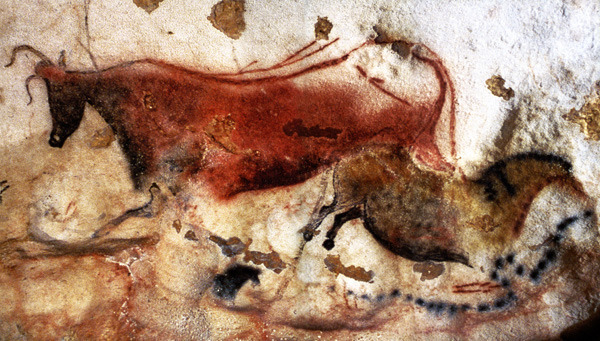Art History: The Lascaux Cave Paintings
The Caves at Lascaux in southwestern
France, are famous the world over for the paintings on their walls.
These are some of the earliest paintings found, and are dated around
15,000-17,000 BC, and were discovered by a group of teenagers in
1940. Like the Chauvet Cave Paintings, the Caves at Lascaux were
protected for thousands of years by a landslide which sealed off all
access.
The
caves were open to the public in 1948.By 1955, some of the cave's art
began to deteriorate due to all the visitors and the change in the
cave's climate. Lichens and crystals and fungus appeared, which were
not present before. As a result, the caves were closed in 1963, with
access granted only to a few scientists. Still today, only a few
scientists are permitted, and the scientific community is working to
preserve and restore the paintings.
In
1983, an exact replica of the Great Hall of the Bulls and the Painted
Gallery, created under Monique Peytral, was opened a short distance
from the original cave, for visitors to see. This is known as
“Lascaux II”.
The
caves contain around 2,000 figures of animals, humans, and abstract
signs. They are simply drawn, and depict humans and animals that were
native to the area, including horses, stags, cattle, buffalo, cats,
bears, and more, as well as abstract geometric shapes, and hand
stencils. These were painted onto the walls with mineral pigments,
and some were etched into the stone. This is one of the earliest
examples of color painting that has been discovered.
The
prehistoric artists used broad, rhythmic outlines around areas of
color. The animals are depicted in a slightly twisted perspective,
with heads in profile, and horns painted from the front, similarly to
the perspective used in Egyptian art.
Do
not think that just because these paintings are primitive, that the
artists were not intelligent. On the contrary, these paintings
required much preparation and forethought. The artists had to create
their tools and gather resources: they had to create their painting
and engraving tools and collect their painting pigments, which
included charcoal and specific minerals, and grind them into powder.
Preparation of the painting surfaces was necessary, so they would
need to scrape and clean the cave walls and roof, as well as do the
preparatory sketch. Scaffolding had to be built to reach high areas.
What
is the meaning behind this art? There are a few different ideas on
this. One idea is that hunters would paint the animal that they were
about to hunt and kill. This painting would place the animal under a
spell, and dominate it. This is called “sympathetic magic”. It
was a type of visualization exercise---if they could visualize it,
they they could achieve it.
Something
important to note, is that each animal species painted, represents a
specific period on the calendar, according to their mating habits,
such as horses represent the end of winter and beginning of spring,
stags represent fall, etc. The abstract signs can also be divided
into twelve different groups; perhaps this cave was a type of
calendar or hunting guide.
The
most accepted explanation for the Lascaux Cave Paintings is that they
were part of a spiritual ritual. Some type of ritualistic ceremony
was performed there, whether for hunting, coming of age, or some kind
of sacrifice.
Regardless
of the original meaning, which we can only guess at, this remains:
early man was intelligent, resourceful, and artistic. He was able to
classify animals according to type as well as separate them into
mating seasons. Also, he left us a pictorial record of the animals
native to that area of France, as well as a simplistic beauty in the
art itself.







Comments
Post a Comment